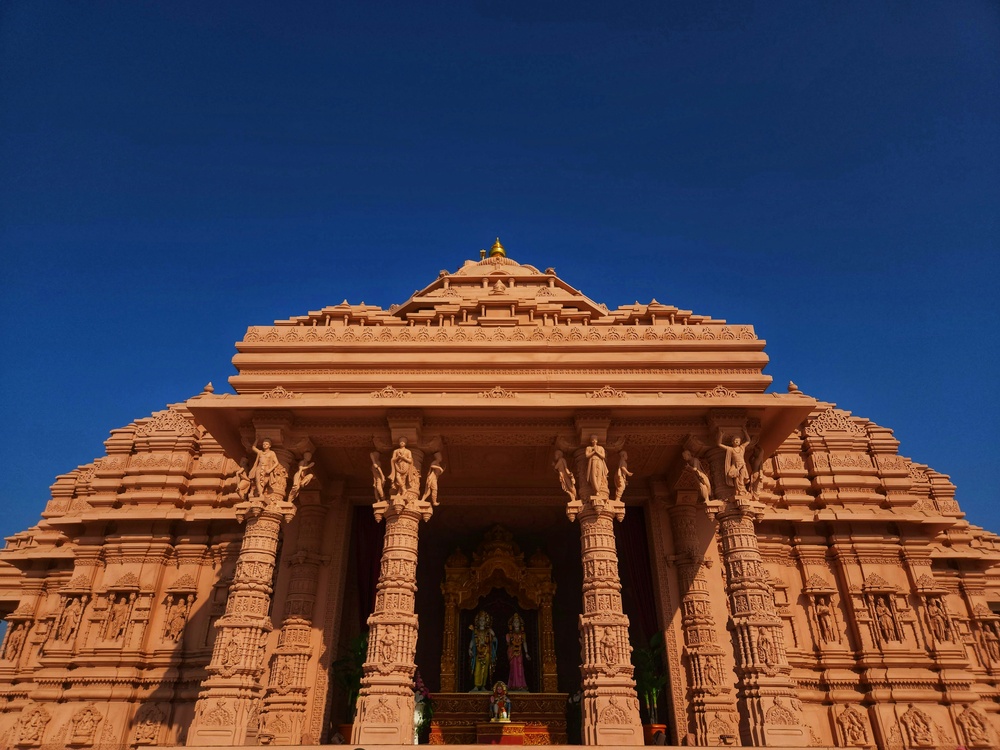Ayodhya, the sacred city located on the banks of the Sarayu River in Uttar Pradesh, is renowned as the birthplace of Lord Ram and holds an unbreakable bond with Hindu faith and mythology. Its temples, ghats, and heritage sites are not just architectural wonders but symbols of devotion and cultural heritage. If you are planning a spiritual journey, here is why these are the best Ayodhya visiting places for your next pilgrimage trip.
1. Ram Janmabhoomi
Ram Janmabhoomi is the holiest place in Ayodhya as it is believed to be the exact birthplace of Lord Ram. The grandeur of the newly constructed Ram Mandir stands as a testament to faith and devotion. Pilgrims from all over India visit to offer prayers, experience spiritual peace, and witness the historical significance of this sacred land. The vibrations here instil a deep sense of divinity and fulfilment in every devotee.
2. Hanuman Garhi
A visit to Ayodhya is considered incomplete without seeking blessings at Hanuman Garhi. This 10th-century temple is dedicated to Lord Hanuman, who is believed to have protected Ayodhya from evil. Situated atop a hillock with around 76 steps, the temple houses a beautiful idol of Hanuman with his mother Anjani. The panoramic view of Ayodhya from here and the spiritual energy make it one of the best Ayodhya visiting places.
3. Kanak Bhawan
Kanak Bhawan is a temple dedicated to Lord Ram and Goddess Sita. It is said to have been gifted to Sita by Kaikeyi after her marriage to Ram. The golden-crowned idols of Ram and Sita inside the temple reflect its name ‘Kanak’ meaning gold. Its intricate architecture, vibrant colours, and peaceful ambience attract pilgrims who wish to experience devotion in a divine and aesthetically beautiful setting.
4. Nageshwarnath Temple
Established by Kush, the son of Lord Ram, Nageshwarnath Temple is dedicated to Lord Shiva. It is one of Ayodhya’s most ancient temples and holds special significance during Shivratri when devotees gather for grand celebrations. Its historical relevance and spiritual aura make it an important stop for pilgrims seeking blessings of Lord Shiva along with Ram.
5. Treta Ke Thakur
Treta Ke Thakur temple is believed to be built at the site where Lord Ram performed Ashwamedha Yagna. The temple houses beautiful black stone idols of Ram, Sita, Lakshmana, Bharat, Shatrughna, and Hanuman, carved from a single stone. It opens only once a year on Ekadashi after Diwali, making it a rare and spiritually significant place to visit in Ayodhya.
6. Sita Ki Rasoi
Located near Ram Janmabhoomi, Sita Ki Rasoi is an ancient kitchen believed to have been used by Goddess Sita. Today, it is a temple displaying symbolic utensils and idols of Sita, Ram, Lakshmana, Bharat, and Shatrughna. This site gives pilgrims a glimpse into the royal household life of Lord Ram’s era, enhancing the cultural and spiritual experience of your pilgrimage.
7. Guptar Ghat
Guptar Ghat is one of the most sacred ghats in Ayodhya. According to legends, it is the site where Lord Ram took Jal Samadhi to return to Vaikuntha. Pilgrims take a holy dip here, believing it to cleanse their sins and bestow divine blessings. The ghat’s peaceful surroundings, along with temples dedicated to Ram and Chakrahari Vishnu, make it an ideal place for meditation and spiritual reflection.
8. Ram Ki Paidi
Ram Ki Paidi is a series of ghats along the Sarayu River, built for pilgrims to take ritual baths and perform religious ceremonies. The evening aarti here, with countless diyas floating on the river, is a divine sight that leaves every visitor mesmerised. Its spiritual importance and scenic beauty make it a top choice among Ayodhya visiting places for pilgrims.
9. Dashrath Mahal
Dashrath Mahal, located near Hanuman Garhi, is believed to be the residence of King Dashrath, father of Lord Ram. It has been converted into a temple with idols of Ram, Sita, Lakshmana, Bharat, and Shatrughna adorned in colourful attire. Its palace-like architecture, grand entrance, and devotional environment attract visitors who wish to experience the royal heritage of Ayodhya.
10. Mani Parbat
Mani Parbat is a small hillock offering panoramic views of Ayodhya. According to legends, it is a part of the Sanjeevani mountain carried by Hanuman. The hill has a Buddhist stupa and a temple, making it an ideal spot for those seeking spiritual peace along with historical exploration.
Why Choose Ayodhya for Your Next Pilgrimage
These Ayodhya visiting places are not just religious sites but represent the eternal faith, history, and cultural heritage of India. A pilgrimage trip to Ayodhya allows you to:
- Reconnect with faith and devotion in the birthplace of Lord Ram.
- Experience ancient Indian architecture and culture through its temples and heritage sites.
- Immerse in spiritual activities like aarti, meditation, and rituals at ghats.
- Witness the grandeur of Ram Mandir, a symbol of collective devotion.
- Learn the legends of Ramayana through historical sites like Treta Ke Thakur and Sita Ki Rasoi.
Conclusion
Ayodhya’s temples, ghats, and heritage sites make it one of the most divine pilgrimage destinations in India. Visiting these best Ayodhya visiting places will not only bless your soul with spiritual peace but also take you on a journey through India’s timeless legends and cultural roots. Plan your pilgrimage trip to Ayodhya and experience the land of Lord Ram in its purest and most divine form.


